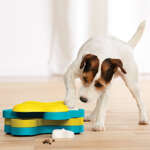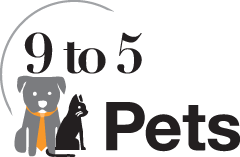Contributed by Jennifer Dew, 9 to 5 Pets
If  you’ve been working remotely from home during the pandemic and are planning to return to work in the coming months, this transition can mean a huge change for your pet. Dogs especially are social creatures by nature. And chances are your pet has been relishing in your company and the opportunity to have you home more. So when you transition back to work, this change in your daily life and your pet’s routine could trigger separation anxiety, and especially if they are your only pet.
you’ve been working remotely from home during the pandemic and are planning to return to work in the coming months, this transition can mean a huge change for your pet. Dogs especially are social creatures by nature. And chances are your pet has been relishing in your company and the opportunity to have you home more. So when you transition back to work, this change in your daily life and your pet’s routine could trigger separation anxiety, and especially if they are your only pet.
Signs of Anxiety:
-
- Your pet follows you from room to room when you are preparing to leave
-
- Pacing/restlessness
-
- Shaking/trembling/hiding
-
- Tail tucking
-
- Excessive salivating
-
- Excessive licking or chewing, which may result in reddened skin or bald patches
-
- Vomiting
-
- Excessive barking/whining/meowing
-
- Aggression
-
- Destructive behavior, often directed at the exits (windows and doors) or clothing or other items that have your scent
-
- Soiling in the home
-
- Change in appetite or weight
-
- A panic attack that leads to your pet hurting itself while trying to escape the house or crate
To help prepare your pets for your upcoming return to work, here are some things you can do now while you are still at home to help ease the transition when it comes:
 Teach your pet independence while you are together by encouraging them to explore other spaces. Using place, down, and stay cues will help with this.
Teach your pet independence while you are together by encouraging them to explore other spaces. Using place, down, and stay cues will help with this.- Teach them to associate your absence with a positive reward such as their favorite toy or a high value treat like a Kong toy filled with frozen peanut butter, freeze dried liver, or their favorite jerky.
- Practice leaving your pet for short periods of time and gradually increase the duration of their alone time. Remember to set them up for success so they can continue to learn. Don’t push them too far too fast.
- Provide a safe space for your dog or cat to retreat to when they are feeling anxious. This could be a crate or gated space for a dog and a quiet, darker space that’s tucked away for a cat.
- Ignore and gently discourage needy behaviors like scratching or excessively seeking attention, to help them become more self sufficient.
Here are several things you can do once you return to work to make it easier on your pets:
 Tire out your pet before you leave. Excess energy is more likely to turn into nervous energy which fuels separation anxiety. A long walk or run with your dog or vigorous play sessions with your cat before work will help mentally stimulate and tire them out.
Tire out your pet before you leave. Excess energy is more likely to turn into nervous energy which fuels separation anxiety. A long walk or run with your dog or vigorous play sessions with your cat before work will help mentally stimulate and tire them out.- Keep your pet busy with games that are mentally stimulating for them. Puzzles and slow dispense treat toys are great for both dogs and cats. And your feline friends will also appreciate window perches, scratching posts/pads, and catnip filled toys.
- Maintain a calm energy when you leave and come back home. It’s hard to ignore your pet’s greeting, especially when they are super excited to see you. But giving them too much excited energy and affection during these times can heighten their anxiety around arrivals and departures.
 Switch up your routine when you leave. Pets are smart and can pick up on departure cues like grabbing your bag, jingling your keys, and putting on your shoes. Try to mix it up as much as possible so they don’t relate these cues with you leaving and subsequent anxiety.
Switch up your routine when you leave. Pets are smart and can pick up on departure cues like grabbing your bag, jingling your keys, and putting on your shoes. Try to mix it up as much as possible so they don’t relate these cues with you leaving and subsequent anxiety.- In cases of severe anxiety, speak with your vet. They may recommend calming aids such as calming collars, thunder shirts, pheromone diffusers, or an anti-anxiety medication.
 If you need mid-day dog walks, off leash pack adventures to the beach or park, kitty enrichment visits, or potty breaks for your new puppy, our 9 to 5 Pets Team will be here for you to help ensure your pets get the exercise, playtime and enrichment they need to help alleviate their stress when you transition back to work. Call us at (904) 655-4700 or fill out our online Contact Form today to get started. We look forward to meeting you and caring for your pets!
If you need mid-day dog walks, off leash pack adventures to the beach or park, kitty enrichment visits, or potty breaks for your new puppy, our 9 to 5 Pets Team will be here for you to help ensure your pets get the exercise, playtime and enrichment they need to help alleviate their stress when you transition back to work. Call us at (904) 655-4700 or fill out our online Contact Form today to get started. We look forward to meeting you and caring for your pets!
References:

